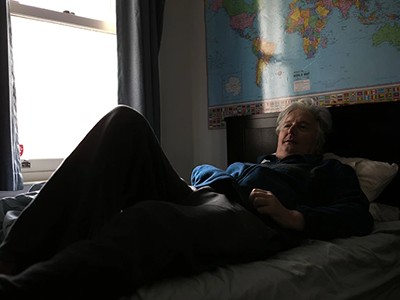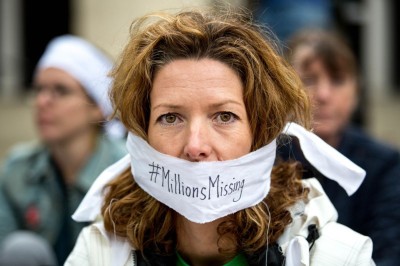
Chronic pain has many manifestations and numerous causes.Credit: Salwan Georges/The Washington Post/Getty
Why does it hurt?
This seemingly simple question doesn’t always have a simple answer. Pain is generally regarded by researchers and medical practitioners as the body’s warning system for a biomechanical problem: it is the alarm for when a finger has a cut, a joint is inflamed or a tumour is growing. Medical professionals will treat the underlying problem, and the pain is expected to recede. But what happens when the alarm doesn’t turn off? What happens when the pain doesn’t stop, long after tissues have healed? What happens when there’s pain even in the absence of tissue damage? Some answers can be found in a Feature in Nature this week.
Chronic pain can be treated — so why are millions still suffering?
Pain itself is a medical condition. Chronic pain, generally defined as pain that lasts for more than three months, affects millions of people worldwide every day. It is likely to affect more of us in the coming decades, in line with increases in the incidence of obesity, diabetes and autoimmune diseases. All of these conditions increase a person’s likelihood of developing chronic pain. Pain is also one of the symptoms that can linger after a SARS-CoV-2 infection. Even in triple-vaccinated adults, around 4% of people with breakthrough infections of the Omicron variant develop long COVID.
Chronic pain has many manifestations and numerous causes, and basic research in neuroscience and immunology has contributed much to our understanding of it. Geneticists and epidemiologists are probing the heritable and environmental factors that contribute to the risks. It is also becoming clearer that chronic pain is tied to a complex mix of neurological, immunological, psychological and social factors. Various factors and processes can drive a person’s pain and might change over time.
Wanted: integrative care
But the multifactorial nature of pain is often not recognized by the medical establishment, especially by clinicians. Medical research is starting to engage with this biopsychosocial model of pain, and therapies have been developed that can — to some extent at least — help to quieten those unrelenting alarms. But accessing the right combination of treatments, or any treatment at all in some cases, is not easy. One considerable hurdle is the lack of recognition of the value of interventions such as yoga, acupuncture and psychotherapy, in addition to medicines. In some cases, health-care policies and insurance systems are also a barrier.
Long COVID: let patients help define long-lasting COVID symptoms
For example, integrative care (such as that involving pain psychologists, physical therapists and spinal specialists) can sometimes be more effective in treating chronic pain than are single interventions, such as steroid injections. However, in the United States, health-insurance plans often exclude these more-complex treatment plans. Furthermore, some US health-care providers are known to favour those interventions for which they are paid more by insurers, even if there are more effective (but less lucrative) alternatives. If a clinician is paid the same for administering a 30-minute steroid injection as for providing a much longer course of treatment, this could be seen as incentivizing the shorter, more lucrative option. The country’s lack of both universal health coverage and mandatory paid sick leave also prevents many people from benefiting from the treatment options available to them.
Change societal attitudes
Of course, problems surrounding access to treatments are not unique to countries without universal health care. In Australia, it’s not unusual for people to have to drive for five or six hours to reach a pain clinic. In the United Kingdom, people using the National Health Service typically face a year-long waiting list before they can start a pain-management programme.
Many of the issues surrounding access to treatments can be traced to individual and societal attitudes that fail to prioritize chronic pain and chronic conditions. Some even fail to recognize that a person’s pain is genuine. Despite a wealth of evidence for the neurological underpinnings of fibromyalgia, for example, a study last year revealed that some UK doctors stated in a survey that they don’t think it is a distinct, or real, condition (N. Wilson et al. BMC Health Serv. Res. 22, 989; 2022). Some of the doctors’ responses were so offensive to patients that they were not published, say the study’s authors.
Researchers are clearly helping to answer the question ‘why does it hurt?’, but chronic-pain research needs to be more appropriately funded. The US National Institutes of Health includes pain-research funding in the same category as addiction research, in part owing to the complicated legacy of the use of opioid drugs to treat pain. Both subjects are important and there’s no problem in classifying the funding in this way, in principle. However, two-thirds of one of the world’s largest funding programmes for pain and addiction, the US HEAL Initiative, goes to addiction studies, and one-third to those researching pain. That logic is more difficult to parse.
Approaches that fail to prioritize the many complex drivers of chronic pain and even deny its existence are causing unnecessary suffering for millions. Reform is needed to ensure that people experiencing chronic pain are able to access treatments that are most likely to help them. And the stigma and bias that characterize the medical and societal narrative around chronic pain must end.

 Chronic pain can be treated — so why are millions still suffering?
Chronic pain can be treated — so why are millions still suffering?
 Long COVID: let patients help define long-lasting COVID symptoms
Long COVID: let patients help define long-lasting COVID symptoms
 A reboot for chronic fatigue syndrome research
A reboot for chronic fatigue syndrome research
 Curbing opioid addiction needs more than new drugs
Curbing opioid addiction needs more than new drugs







